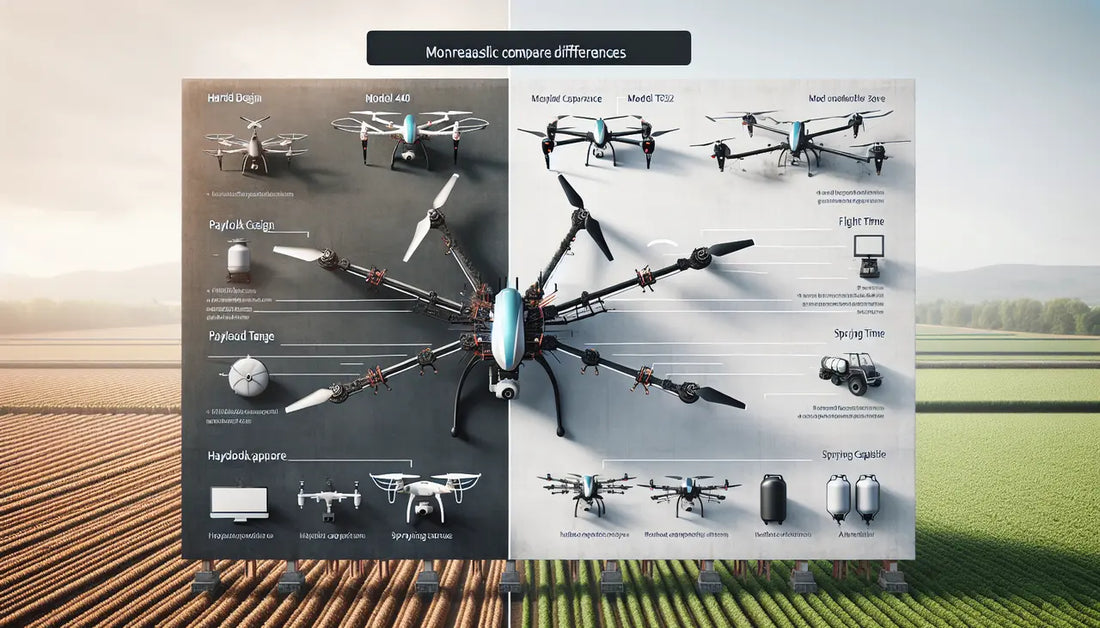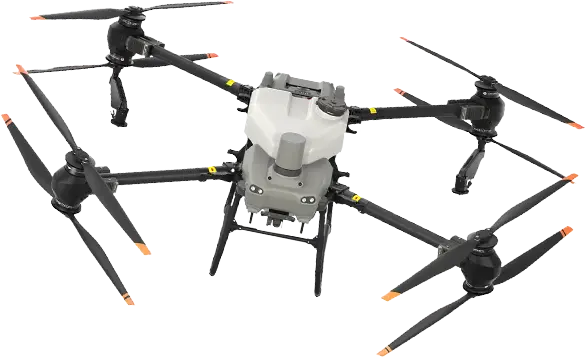
The Main Differences between the DJI Agras T40 vs the DJI Agras T50
Share
Introduction to DJI Agras T40 and T50 Drones
DJI Agras T40 and T50 drones are not your everyday flying gadgets. They’re designed for a big job—agriculture. These drones are built to spray crops, making the job faster, more efficient, and less grueling. The T40 is the previous model, ready and capable, ideal for those just diving into agricultural drones. It’s your go-to for covering fields at a low gallon per acre rate, deploying its features to manage your crops carefully. The T50, on the other hand, is the big sibling with more spraying power, larger impeller pumps, and the ability to cover vast areas in a single flight, saving time and effort for large-scale farming operations. Both these models represent DJI’s commitment to integrating technology with agriculture, but their capabilities and uses differ, catering to a wide range of needs in the farming industry. Whether you’re managing a small vineyard or vast crop fields, there’s a DJI Agras drone designed to meet your agricultural demands.
Overview of the DJI Agras T40 Features
The DJI Agras T40 is designed for efficiency and precision in agricultural spraying. It boasts a robust system that allows for precise application of liquids, benefiting crop yields and resource management. Key features include a 40-liter spray tank that can cover a good amount of land quickly. It’s equipped with smart farming tools like the DJI Agras Smart Agricultural Management System, making it not just a drone, but a farming partner that can plan and execute spraying missions efficiently. The drone also showcases advanced safety features, ensuring operations are safe for both the drone and its surroundings. With its strong build and intelligent systems, the T40 is set to revolutionize how farming is done, making it simpler, smarter, and more effective.
Exploring the Unique Features of the DJI Agras T50
The DJI Agras T50 takes agricultural drone tech up a notch. What sets it apart? For starters, it has a smart liquid tank. This means the drone can adjust its spraying based on real-time feedback, making every drop of pesticide or fertilizer count. Then there’s the enhanced flight performance. The T50 sprays faster, thanks to improved impeller pumps. It means you cover more ground with less time and effort. Safety gets a boost with the T50 as well. Its dual binocular vision sensors and dual 360-degree omnidirectional radar systems sees obstacles in all directions, letting the drone dodge them like a pro. Lastly, with its AI farming assistant, the T50 not just flies; it thinks. It maps out the most efficient spraying paths and adjusts to changing crop and weather conditions on the fly. It’s like having an expert farmer navigating from above. So, the T50 isn’t just another drone – it’s a smart, flying farmhand.
Key Differences in Design and Build Quality
When we talk about the DJI Agras T40 and the DJI Agras T50, it’s clear they come from the same family but with some key changes in design and build quality that set them apart. Let’s dive straight in.
First off, the T40 boasts a rugged build that’s designed to withstand the rigors of agricultural spraying. It feels solid and is made to last. On the flip side, the T50, while maintaining a strong build, steps it up with enhanced materials that increase durability and resistance to corrosion. This makes the T50 a bit more resilient, especially in varied environmental conditions.
Design-wise, the T40 keeps things straightforward and functional, which is great for ease of use and maintenance. However, the T50 introduces sleeker lines and a more aerodynamic profile. This isn’t just about looks; it improves the drone’s efficiency in the air, making it capable of covering larger areas more effectively.
Another point to mention is the upgrade in the T50’s structural integrity. It’s equipped with a more advanced frame that helps in reducing vibration during flight. This improvement is crucial as it leads to more precise spraying and, ultimately, less waste of resources.
In summary, while the T40 presents a strong and capable design for everyday agricultural needs, the T50 ups the ante with superior materials, a more thoughtful design aimed at efficiency, and upgrades that bolster its performance and longevity. Each has its strengths, but the choice between them will depend on your specific needs and how much you value the enhancements the T50 brings to the table.
Comparing Flight Performance: T40 vs T50
When looking at the DJI Agras T40 and the T50, their flight performance tells a significant part of their story. Both are designed for agricultural use, but they bring different strengths to the field. The T40 is known for its agility. It’s lighter, making it easier to navigate through tighter spaces, a big plus in uneven terrains or dense crops. It has a solid flight time that allows for efficient work without constant landings for battery swaps.
On the flip side, the T50 ups the game with an emphasis on power and coverage area. Thanks to its more robust design and improved impeller pumps, the T50 can cover vast areas without needing a recharge, making it ideal for large farms or plantations. Its flight stability, even in less-than-ideal weather conditions, ensures that the T50 delivers consistent performance no matter what mother nature throws at it.
So, in the showdown of flight performance between the T40 and T50, it’s not just about which is better. It’s about which suits your needs more closely. If you value maneuverability and the ability to work in tight spaces, the T40 might be your pick. But if endurance and the ability to cover large areas quickly are your top priorities, then the T50 could be the way to go. Both models showcase DJI’s commitment to making agricultural tasks more manageable and efficient, with the difference mainly lying in how they meet the specific needs of their users.
Payload Capacities: A Detailed Look
In the drone world, payload matters, especially when we’re talking about agricultural drones like the DJI Agras T40 and T50. So, let’s dive straight in. The DJI Agras T40 boasts a liquid payload capacity of up to 40 liters. It’s built to handle that weight effortlessly, making it a solid choice for various agricultural tasks. On the other hand, the DJI Agras T50 steps it up with a payload capacity reaching up to 50 liters with the optional orchard spray package (50L tank not available to North American at this time). This extra capacity allows the T50 to cover larger areas or carry more of whatever it needs, be it seeds, fertilizers, or pesticides. Simply put, if you need to haul more in one go, the T50 has got your back. But it’s not just about carrying more. The efficiency and capability of handling that extra weight smoothly can make a big difference in your farming operations. Think about it — more payload means fewer trips, saving time and potentially increasing the area you can cover in a day. Just remember, the choice between the T40 and T50 doesn’t hinge solely on payload. Consider the size of your farm, the types of crops, and your specific needs. However, when it comes to lifting power, the T50 clearly leads the pack.
Battery Life and Power Efficiency Compared
When we talk about battery life and power efficiency in the DJI Agras T40 and the DJI Agras T50, we’re hitting the heart of what makes these drones stand out for agricultural use. The T40 comes equipped with a battery that can support up to 12 minutes of flight time. This makes it solid for covering fields with a low gallon per acre rate or targeted spraying tasks. On the flip side, the T50 takes it up a notch. It boasts a battery life that can keep it airborne for up to the same minutes but, with better impeller pumps it can spray more liquid quicker leaving more battery at the end of a tank. This extra juice means you can cover more ground on a single battery, making it perfect for larger areas.
Power efficiency isn’t just about how long these drones can stay in the air; it’s also about how they use that power to get the job done. The T40 is designed to be efficient and effective for its size, offering precise spraying with minimal waste. However, the T50 is where DJI has really pushed the envelope. It uses advanced algorithms to optimize its flight and spraying patterns, ensuring that not a drop of spray is wasted and that each pass is as efficient as possible.
In summary, if your main concern is maximizing your time in the air and covering larger plots of land with precision, the T50 takes the crown. But don’t count the T40 out; its efficiency and effectiveness in smaller spaces are nothing to sneeze at.
Software and Control Systems: Which Is More User-Friendly?
When comparing the DJI Agras T40 and the DJI Agras T50 drones, their software and control systems are crucial for ease of use. Both drones come equipped with DJI’s sophisticated flight control systems, but there are nuances that might tip the scale for potential users. The T40 is designed with simplicity in mind, making it a go-to for those new to agricultural drones or preferring straightforward operations. Its interface is intuitive, ensuring users can navigate the system without a steep learning curve. This drone prioritizes user-friendly operations, allowing for quick setup and deployment in the field.
On the other hand, the T50 packs more advanced software features aimed at optimizing agricultural tasks. It offers enhanced data analysis tools and a more complex control system that, while potentially offering higher efficiency, also requires a bit more time to master. The T50’s software is a powerhouse for precision agriculture, providing detailed insights into crop health, irrigation needs, and more. However, this advanced capability means users will need to invest time in learning the system to utilize its full potential.
In summary, if you’re after simplicity and ease of use straight out of the box, the T40 is your drone. But if you seek advanced features and are willing to climb the learning curve, the T50’s sophisticated software and control systems offer a comprehensive tool for precision farming.
Pricing and Value for Money
When it comes to farming solutions, the DJI Agras T40 and T50 drones are top contenders. But what about their pricing and value? The T40 is generally more wallet-friendly than the T50. That said, the choice between them isn’t just about initial cost. It’s about what you get for your money. The T40 comes packed with essential features suitable for smaller or medium-sized farms. It’s designed for efficiency and effectiveness, without all the extra bells and whistles. On the other hand, the T50, while more expensive, offers advanced capabilities. Think of it as an investment. For larger operations or more complex agricultural needs, the T50’s enhanced features, like increased spray capacity and longer flight times, provide significant long-term value. In essence, the T40 offers great functionality at a more accessible price point, making it a strong entry-level choice. The T50, with its higher price tag, is justified by its superior tech specs and capabilities, aimed at larger scale or more technologically sophisticated farming operations. So, when deciding, consider your farm’s size and needs alongside your budget.
Conclusion: Choosing the Right Drone for Your Agricultural Needs
Deciding between the DJI Agras T40 and the T50 boils down to what you need on your farm. The T40 is a great starter if you’re just dipping your toes into agricultural drones. It’s cheaper, still packs plenty of tech to get the job done and is a solid choice for smaller operations. On the flip side, if your farm spans wider acres or you’re looking to scale, the T50 is your beast. It covers more ground per battery, disperses more liquid, and its advanced tech can save you time and money in the long run. Think about your farm size, crop types, and how much you’re willing to invest upfront. There’s no wrong choice here, just what’s best for your fields.

